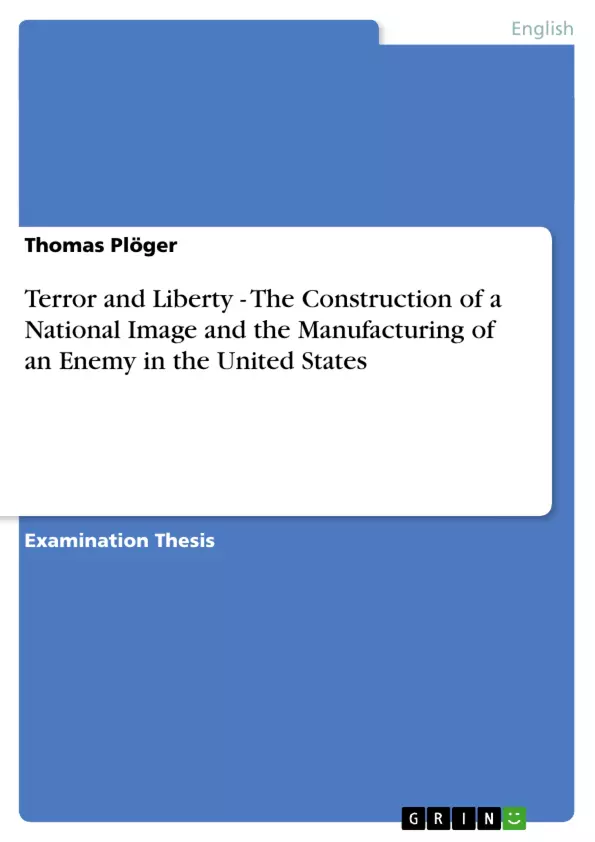This paper contains an analysis of the rhetoric that was employed by President George W. Bush to describe the events of 9/11 and their consequences. This interest arises from the assumption that the presidential rhetoric had a powerful influence on the chain
of events that followed after the attack on the WTC and that many if not most of the
initial reactions were based on meanings that were constructed by the government. It
is the task of this essay to show that the most crucial influences that the President
had on the discourse were his constructions of the American people and the terrorist
enemies and his definition of the 9/11 attacks as an act of war.
The rhetoric that was used to convey these concepts is, in its terminology and imagery, specific to US American culture. It therefore largely works, as this essay intends to show, within a specifically American framework of cultural references.
The essay isolates a number of narrative paradigms that the presidential rhetoric either adopts or constructs and keeps returning to as motifs for the construction of its overall rationale.
Inhaltsverzeichnis (Table of Contents)
- Introduction
- Instruments
- Discourse Analysis
- Narrative
- Nation
- National Identity
- Identity
- Discursive Strategies
- The Functions of Enemy Images in Self-Identification
- The U.S. and National Identity
- American Enemy Images in the 20th century
- Political Culture
- Definition of Political Culture
- Political Culture in the United States
- Liberal Tradition
- Republicanism
- Religious Tradition
- Civil Religion
- Tradition of Sacrifice
- The American Can-Do Spirit
- The National Habitus
- Analysis of President George Bush's post-9/11 rhetoric
- Analysed Material
- The 'Address to a Joint Session of Congress and the American People'
- Structure & Content of the Speech
- Narrative
- The Paradigms
- Paradigm 1: Nation Under Attack
- Paradigm 2: World View
- Paradigm 3: Freedom Rationale
- Nature of Freedom
- Paradigm 4: A Great Cause
- Paradigm 5: War
- Paradigm 6: Sacrifice and Unity
- Paradigm 7: The Evil Nature of the Enemy
Zielsetzung und Themenschwerpunkte (Objectives and Key Themes)
This paper analyzes President George W. Bush's post-9/11 rhetoric, focusing on its influence on the subsequent events. The analysis assumes that the presidential rhetoric significantly shaped initial reactions and interpretations of the 9/11 attacks. The study aims to demonstrate how the President's construction of the American people and their enemies, and his framing of 9/11 as an act of war, played crucial roles in shaping the discourse.
- Construction of the American national image post-9/11
- The portrayal of the enemy in President Bush's rhetoric
- The framing of 9/11 as an act of war and its implications
- Analysis of discursive strategies employed by President Bush
- The relationship between national identity and the construction of an enemy
Zusammenfassung der Kapitel (Chapter Summaries)
The Introduction sets the context by discussing the "war on terror" and the events of September 11th, 2001, highlighting their impact on American society and the subsequent governmental response. The section on Instruments outlines the methodological approaches used in the analysis, including discourse analysis, narrative analysis and concepts of nation and identity. The chapter on Political Culture delves into the defining aspects of American political culture, including its liberal, republican, and religious traditions. The Analysis of President George Bush's post-9/11 rhetoric section examines President Bush's speech to Congress, focusing on its structure, narrative, and the paradigms employed to construct meaning.
Schlüsselwörter (Keywords)
American national identity, post-9/11 rhetoric, enemy image construction, discourse analysis, political culture, war on terror, President George W. Bush, September 11th, 2001, narrative analysis, national unity, Homeland Security.
- Quote paper
- Thomas Plöger (Author), 2005, Terror and Liberty - The Construction of a National Image and the Manufacturing of an Enemy in the United States, Munich, GRIN Verlag, https://www.grin.com/document/122338



